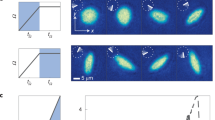Abstract
Superfluids are distinguished from normal fluids by their peculiar response1 to rotation: circulating flow in superfluid helium2,3, a strongly coupled Bose liquid, can appear only as quantized vortices4,5,6. The newly created Bose–Einstein condensates7,9—clouds of millions of ultracold, weakly interacting alkali-metal atoms that occupy a single quantum state—offer the possibility of investigating superfluidity in the weak-coupling regime. An outstanding question is whether Bose–Einstein condensates exhibit a mesoscopic quantum analogue of the macroscopic vortices in superfluids, and what its experimental signature would be. Here we report calculations of the low-energy states of a rotating, weakly interacting Bose gas. We find a succession of transitions between stable vortex patterns of differing symmetries that are in general qualitative agreement with observations5 of rotating superfluid helium, a strong-coupling superfluid. Counterintuitively, the angular momentum per particle is not quantized. Some angular momenta are forbidden, corresponding to asymmetrical unstable states that provide a physical mechanism for the entry of vorticity into the condensate.
This is a preview of subscription content, access via your institution
Access options
Subscribe to this journal
Receive 51 print issues and online access
$199.00 per year
only $3.90 per issue
Buy this article
- Purchase on Springer Link
- Instant access to full article PDF
Prices may be subject to local taxes which are calculated during checkout



Similar content being viewed by others
References
Leggett, A. J. in Low Temperature Physics (eds Hoch, M. J. R. & Lemmer, R. H.) 1–92 (Springer, Berlin, (1992)).
Onsager, L. Nuovo Cimento 6, 249–250 (1949).
Feynman, R. F. in Progress in Law Temperature Physics Vol. I(ed. Gorter, C. J.) 17–53 (North Holland, Amsterdam, (1955)).
Vinen, W. F. Single quanta of circulation in helium II. Proc. R. Soc. Lond. A 260, 218–236 (1961).
Yarmchuk, E. J., Gordon, M. J. V. & Packard, R. E. Observation of stationary vortex arrays in rotating superfluid helium. Phys. Rev. Lett. 43, 214–217 (1979).
Ruutu, V. M. H. et al. Vortex formation in neutron-irradiated superfluid 3He as an analogue for cosmological defect formation. Nature 382, 334–336 (1996).
Anderson, M. H., Ensher, J. R., Matthews, M. R., Weiman, C. E. & Cornell, E. A. Observation of Bose-Einstein condensation in a dilute atomic vapor. Science 269, 198–201 (1995).
Davis, K. B. et al. Bose-Einstein condensation in a gas of sodium atoms. Phys. Rev. Lett. 75, 3969–3973 (1995).
Bradley, C. C., Sackett, C. A. & Hulet, R. G. Bose-Einstein condensation of litium: observation of limited condensate number. Phys. Rev. Lett. 78, 985–989 (1997).
Inouye, S. et al. Observation of Feshbach resonances in a Bose-Einstein condensate. Nature 392, 151–154 (1998).
Jin, D. S., Ensher, J. R., Matthews, M. R., Wieman, C. E. & Cornell, E. A. Collective excitations of a Bose-Einstein condensate in a dilute gas. Phys. Rev. Lett. 77, 420–423 (1996).
Mewes, M. O. et al. Collective excitations of a Bose-Einstein condensate in a magnetic trap. Phys. Rev. Lett. 77, 988–991 (1996).
Marzlin, K., Zhang, W. & Wright, E. M. Vortex coupler for atomic Bose-Einstein condensates. Phys. Rev. Lett. 79, 4728–4731 (1997).
Dum, R. & Castin, Y. Creation of dark solitons and vortices in Bose-Einstein condensates. Phys. Rev. Lett. 80, 2972–2975 (1998).
Landau, L. D. & Lifshitz, E. M. Statistical Physics 3rd edn (Pergamon, Oxford, (1980)).
Baym, G. & Pethick, C. J. Ground-state properties of magnetically trapped Bose-condensed rubidium gas. Phys. Rev. Lett. 76, 5–8 (1996).
Dalfovo, F. & Stringari, S. Bosons in anisotropic traps: ground state and vortices. Phys. Rev. A 53, 2477–2485 (1996).
Wilkin, N. K., Gunn, J. M. F. & Smith, R. A. Do attractive bosons condense? Phys. Rev. Lett. 80, 2265–2268 (1998).
Hess, G. B. Angular momentum of superfluid helium in a rotating cylinder. Phys. Rev. 161, 189–193 (1967).
Hall, H. E. On the rotation of liquid helium II. Adv. Phys. 9, 89–146 (1960).
Campbell, L. J. & Ziff, R. M. Vortex patterns and energies in a rotating superfluid. Phys. Rev. B 20, 1886–1902 (1979).
Rokhsar, D. S. Vortex stability and persistent currents in trapped Bose gases. Phys. Rev. Lett. 79, 2164–2167 (1997).
Rokhsar, D. S. Dilute Bose gas in a torus: vortices and persistent currents.Preprint cond-mat/9709212 at 〈http://xxx.lanl.gov〉 ((1997)).
Singh, K. G. & Rokhsar, D. S. Collective excitations of a confined Bose condensate. Phys. Rev. Lett. 77, 1667–1670 (1996).
Edwards, M. et al. Collective excitations of atomic Bose-Einstein condensates. Phys. Rev. Lett. 77, 1671–1674 (1996).
Stringari, S. Collective excitations of a trapped Bose-condensed gas. Phys. Rev. Lett. 77, 2360–2363 (1996).
Mewes, M. O. et al. Bose-Einstein condensation in a tightly confining dc magnetic trap. Phys. Rev. Lett. 77, 416–419 (1996).
Acknowledgements
We thank J. C. Davis, A. L. Fetter, R. E. Packard and D. P. Arovas for comments on the manuscript, and the Institute for Theoretical Physics at Santa Barbara for its hospitality while this work was being completed.
Author information
Authors and Affiliations
Corresponding author
Rights and permissions
About this article
Cite this article
Butts, D., Rokhsar, D. Predicted signatures of rotating Bose–Einstein condensates. Nature 397, 327–329 (1999). https://doi.org/10.1038/16865
Received:
Accepted:
Issue Date:
DOI: https://doi.org/10.1038/16865
This article is cited by
-
Fragmentation and correlations in a rotating Bose–Einstein condensate undergoing breakup
Scientific Reports (2023)
-
Threshold for Blowup and Stability for Nonlinear Schrödinger Equation with Rotation
Annales Henri Poincaré (2023)
-
Poincaré index formula and analogy with the Kosterlitz-Thouless transition in a non-rotated cold atom Bose-Einstein condensate
Journal of High Energy Physics (2022)
-
Vortex precession and exchange in a Bose-Einstein condensate
Journal of High Energy Physics (2021)
-
Information Entropy for a Two-Dimensional Rotating Bose–Einstein Condensate
Journal of Low Temperature Physics (2019)
Comments
By submitting a comment you agree to abide by our Terms and Community Guidelines. If you find something abusive or that does not comply with our terms or guidelines please flag it as inappropriate.



